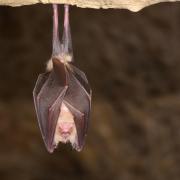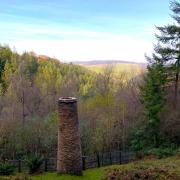Sightings of shrill carder bees are reducing across the country. Richard Rickitt heads to South Somerset, one of the remaining places to spot this rare bee, and learns more about the conservation project
As a county rich in wildlife and unique natural habitats, Somerset has much to offer naturalists. But spotting rare species can sometimes mean serious dedication. However, in a small corner of South Somerset, observing one of the UK’s rarest creatures can involve little more than a gentle stroll around a beautiful garden, perhaps pausing for a cup of tea and a scone. All that’s needed is a little luck, some fine weather and a finely attuned ear.
The UK has some 275 species of bee. About 250 of which are solitary; tiny bees whose females work singly to build nests in walls or holes in the ground and which go largely unnoticed despite perhaps dozens of species living in the average garden. More familiar to most of us are the large, furry, highly charismatic bumblebees, of which the UK has 24 species. Seven or eight of these are commonly found in most gardens, including the buff-tailed bumblebee (Bombus terrestris), southern cuckoo bumblebee (B. vestalis) and garden bumblebee (B. hortorum), all of which have black and yellow stripes and look exactly like every child’s drawing of a bumblebee, and the velvety black, scarlet-tipped beauty that is the red-tailed bumblebee (B. lapidarius). Some of the remaining bumblebee species are increasingly uncommon, and a few are very scarce indeed. Rarest of all is Bombus sylvarum, the shrill carder bumblebee. Once common, it is now found in only a handful of places, with recorded numbers dwindling by the year.

My hunt for this elusive bee began in 2019 when I visited beekeepers on Salisbury Plain, the abundant wildflowers growing there being a rich source of exquisite honey. The Plain was once known to be home to shrill carder bees, although they haven’t been recorded there since 2008. Indeed, my own searches there were fruitless. Last September, as I finished work on a book about gardens and bees, I decided to look again. This time I visited the site of the only known remaining population of shrill carders in the west country at the National Trust property Lytes Cary Manor, near Yeovil.
First built by William le Lyte on the banks of the river Cary, Lytes Cary is a charming medieval manor house constructed from locally quarried blue Lias stone, its slightly austere tones mellowed by dressings of honey-coloured hamstone. Exploring the richly planted borders that surround the house, I stopped to inspect a patch of lamb’s ear (Stachys byzantina), where I spied one of our most charming and unusual solitary bees, the wool carder bee (Anthidium manicatum). The females of this relatively common species visit plants including woundworts, great mullein and yarrow, harvesting the hairs from their leaves and stems and knitting them into cottonwool-ball nests with pockets in which to lay their eggs. The males are highly territorial, staking out plants that females are likely to visit and fending off potential rivals. They fearlessly take on much larger bumblebees and sometimes even challenge humans; hovering at face level and eying you up in a way that is surprisingly intimidating for an insect about the size of a baked bean. They can’t sting, however, and will only ever pick a fight with other flying insects. If you have any hairy plants in your garden, look out for these characterful bees from early summer onwards.
As I pointed out the wool carder bees to my wife, a voice came from behind us; ‘What’s that? Have you seen a shrill carder?’ it asked. I turned to find another couple, also staring intently at the lamb’s ear, and explained authoritatively that I had been looking for wool carder bees, quite different from shrill carders which are very rare and hardly ever seen. ‘Well, we see them here quite a bit,’ came their matter of fact reply. Quite by luck I had met Pam and Alan Brown, locals who regularly visit Lytes Cary to hunt for shrill carders and who are involved with efforts to conserve the bee. They offered to show me the best places to find shrills, starting with the lavender beds and moving to a nearby field margin where a favoured food plant, red bartsia (Odontites vernus), was blooming. After about an hour intently studying every likely flower and flying insect, we were close to giving up when Alan suddenly shouted with glee; he had spotted a shrill. In fact, two specimens were visiting lamb’s ear and clary sage (Salvia sclarea) in the borders to the south of the house.

Shrill carders are one of our smallest bumblebees and, unlike many of their colourful and boldly patterned cousins, their appearance is quite muted. Overall, they have a greyish or straw-coloured appearance with some pale-yellow and grey bands and an inky-black stripe on their thorax. The giveaway is a very pale orange tip to the tail. Unlike some bumblebee species, queens, workers and males all look similar, differing mainly in size. Queens, the only ones to come through winter, often aren’t seen until May, much later than most other bumblebee species. Like other carder bumblebees – of which we have five species in the UK – shrill queens card together dry grasses, roots and moss to make their nests at - or just below - ground level. They produce small colonies, typically comprising fewer than 50 workers compared with perhaps 300 in a colony of buff-tailed bumblebees.
Although once common, numbers of shrill carder bees have plummeted in the past 50 years and just five small, isolated populations remain in England and Wales. The largest UK population is along the Thames Estuary, with smaller populations on the Gwent Levels, Kenfig near Port Talbot, and South Pembrokeshire. Those at Lytes Cary are considered part of a South Somerset population, but numbers here have diminished greatly in recent years and annual recordings are now worryingly low. I spent about 20 minutes watching the shrills with Pam and Alan before rain sent us – and the bees – looking for shelter. In that time, we thought we identified just three individuals. Being small they are quite hard to spot and keep track of, but their giveaway is an unusually high-pitched buzz that is about an octave above that of other bumblebees. It is this audible quirk that gives the bee its common name, although it was once better known as the knapweed bumblebee.
Two weeks later, I returned to meet some of those working to conserve the local population of shrill carders. Mark Musgrave, the National Trust lead ranger at Lytes Cary who looks after 800 acres of land across several local Trust properties, told me how the Trust is managing the land to promote biodiversity. ‘Twelve years ago, the farmland at Lytes Cary was pretty ecologically unfriendly,’ explained Mark. ‘But in 2011 it entered a Higher Level Stewardship scheme and we began to make changes that would make it better for sustaining some of the important species we have here. They include harvest mice, brown hairstreak butterflies, great crested newts and the shrill carder bumblebee.’

The land is tenant farmed, but the Trust specifies how it should be cultivated and managed. In some places, traditional ploughing has been replaced with zero-tillage cultivation which reduces erosion, protects soil structure and beneficial mycorrhizal fungi and leaves stubble on the ground – important for farmland bird species. However, some valuable flowering plants actually benefit from the disturbance of traditional ploughing, so arable fields can have several methods of cultivation applied to them, resulting various habitats. Wild margins next to hedgerows are left to regenerate naturally, producing an array of wildflowers. Much wider margins extending into the field itself are ploughed and harrowed each autumn, allowing grass and wildflowers to grow the following year, flowering and setting seed before the area is mown in late summer. This regime promotes the growth of the kind of annual flowers that once bejewelled all cornfields, like the nationally scarce corn marigold (Chrysanthemum segatum) and spreading hedge parsley (Torilis arvensis). It also encourages red bartsia, which grows locally despite normally being associated with chalkland. Flowering late and with deep flowers suitable for long-tongued bees, red bartsia is an important source of nectar and pollen for the shrill carder. Comfrey, another favourite with the shrill and other long-tongued bees, has also been planted in margins and on the river bank.
Other management changes include underplanting crops of wheat with white clover. The clover supresses weeds, so fewer herbicides are used, and fixes nitrogen in the soil, so less fertiliser is needed. White clover flowers are useful to many species of bees and were the predominant source of British honey until the 1930s, when artificial fertilisers began to replace clover for nourishing arable land. The land at Lytes Cary is not yet organically farmed – although that is an aim – but no insecticides are used. Grassland, now better managed for wildlife, is gradually being converted to flower-rich meadow more akin to that found here a century ago. Hay is cut only after mid-July, allowing flowers to set seed and spread. Because the shrill carder is active much later in the season than many bees, some meadows are not cut until September or October, allowing the late flowering of knapweeds and thistles, among others. This also leaves potential nesting areas undisturbed. No shrill nests have ever been found at Lytes Cary, adding to the difficulty in trying to decide how or where to create suitable habitat for them. However, all carder bees need areas of thatchy grass and moss for nesting, so some grass is left uncut for up to three years.
Catering for shrill carders makes life complicated for Mark because their needs can clash with some other wildlife management aims. “We try to provide plenty of late food for the shrills by not cutting meadows until late in the season, but this allows coarse grasses to set seed and crowd out the wildflowers. As a result, we have a very varied cutting regime, with some grass being cut early, some late and some not at all. Harvest mice, another priority here, require meadows and margins that are left uncut for at least four years. We are still trying to find the best balance, but it's very gratifying to see things improving overall. However, although we know we are doing everything right for the shrill carder, the local population is still in decline. This is something of an oasis and what we do here needs to be replicated much more widely.’

Later I met Jasmine Ely from the Bumblebee Conservation Trust (BBCT), the UK charity that works to record and preserve bumblebee species. Jasmine is one of two people employed by the BBCT in its Save Our Shrills: Somerset project, which is working to understand why shrill carder bees are declining so rapidly. Sightings of shrills in Somerset have been recorded consistently since 2014 but the news is not encouraging. In 2015 there were 144 recorded sightings, falling to 80 in 2017 and then just seven in 2022. Records rose slightly to 25 in 2023. Three of the 2023 sightings were in nearby Kingsdon, a village previously unknown to have shrills but where BBCT organised a bumblebee identification workshop that led almost immediately to more confirmed sightings. Other one-off sightings have been made in South Somerset, including at Curry Rivel, suggesting that more shrills might be found in the area if only more people could search for and accurately identify them.‘We need more data and that is part of what the Save Our Shrills: Somerset project is about,’ Jasmine told me. ‘At present, most of our records are from only a handful of sites that are monitored regularly because we have historic records there. To get the most accurate picture of how shrills are doing in Somerset, we need more people looking more regularly on more sites.’
Causes for the serious decline of shrill carders over the past 50 years probably include loss and fragmentation of habitat resulting from changes in farming practices, as well as the use of agricultural pesticides. Insecticides are of course detrimental, but even weedkillers such Glyphosate are known to diminish bumblebees’ ability to incubate their eggs. Very recent research has also confirmed that bumblebees, whose hairy coats are part of their adaptation to cool climates, are being seriously affected by the warmer summers being brought on by climate change. However, shrills are in drastic decline even where species that share a similar lifestyle, such as the common carder bumblebee (B. pascuorum), continue to be abundant. There could still be undiscovered reasons that account for the decline of shrills in particular. For now, all that can be done is to try to bolster the shrill populations that remain. The work by the National Trust at Lytes Cary helps, but the next job is to try to build bee-friendly connections between areas with known populations. It is hoped this will allow shrills to expand their range and for populations to interconnect, reducing the chances of inbreeding and improving their resilience. ‘We are encouraging local landowners to create and restore flower-rich habitat, particularly where this can act as corridors to connect the known populations,’ said Jasmine. ‘We’re working with some enthusiastic landowners, and we do have some limited resources to help with the costs of carrying out habitat management works similar to those at Lytes Cary. Even if we could get them to make changes on portions of their land, we think it would make a real difference. Many of the areas we initially want to link are quite close to Lytes. Shrills have been recorded recently in Kingsdon (1km to the west), Charlton Mackrell and Charlton Adam (2km north).’ I was both impressed and buoyed by the work being done to help preserve shrill carder bumblebees but equally concerned by how fragile the Somerset population seems to be. The numbers recorded in recent years could mean that only a handful of viable colonies remain, perhaps equalling just a few hundred individuals, and that a particularly cold or wet winter, or some other relatively minor environmental catastrophe, might be all it takes to wipe them out locally.

I did however end my visit on a very positive note. Walking around the National Trust-run allotments to the north of Lytes Cary, I heard a now familiar-sounding buzz and followed it to find two shrill carders foraging on goat’s rue (Galega officinalis). At the same time, I saw the beautiful but very scarce brown-banded carder bee (Bombus humilis). Efforts being made locally to preserve the shrill carder bumblebee will also help the brown-banded carder as well as other rare species such as the ruderal bumblebee (B. ruderatus), moss carder bumblebee (B. muscorum) and red-shanked carder bumblebee (B. ruderarius), reinforcing the importance of the valuable work being done in this small corner of Somerset.
Richard Rickitt's book, Beekeeping for Gardeners is published by Bloomsbury. bloomsbury.com
You can find a species guide to help you identify bees at: bumblebeeconservation.org




























